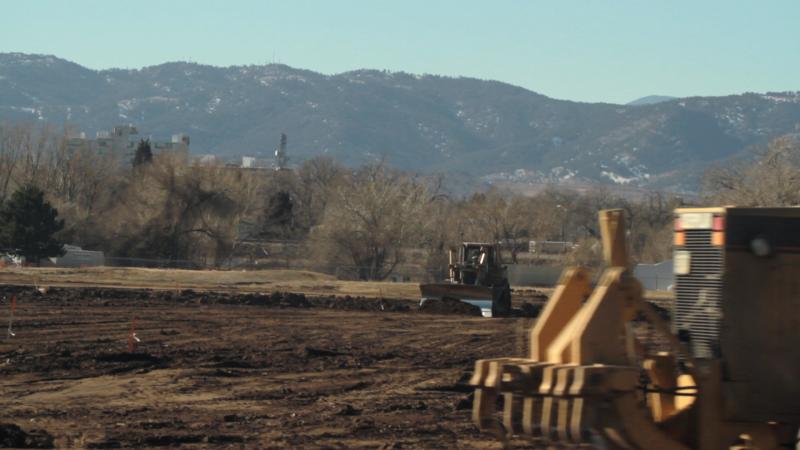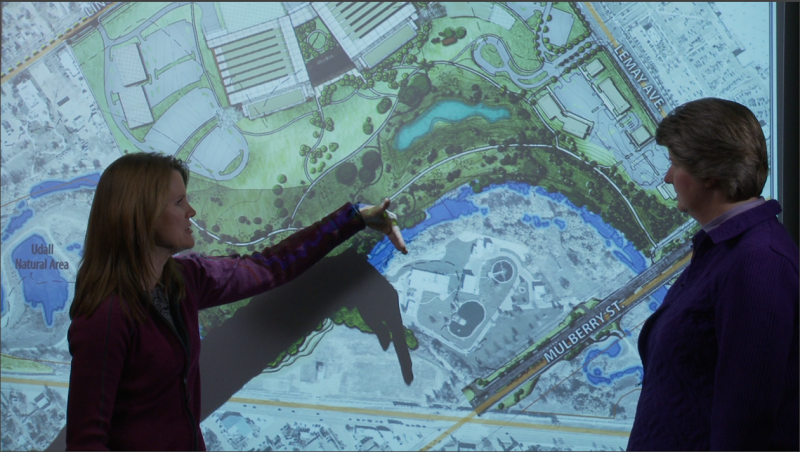Stressors and impacts
Abandoned, unkempt properties can become a problem for cities. For Fort Collins, Colorado, the derelict former golf course near the Cache la Poudre River was more than just an eyesore. When it was originally built in the 1970s, the course was artificially raised in order to keep it from being submerged during flooding events. This created a channel of fast-moving water near the course’s edge, increasing erosion along the riverbanks and the risk of flooding upstream.
After the city purchased the land, officials wanted to sell it to a company that would bring economic growth to Fort Collins. Equally important, they wanted to attract a builder who would develop the land in a way that would accommodate the nearby river and its floodplain. As Fort Collins had past experience with dangerous floods, city officials paid attention to climate projections that indicated a potential increase in the frequency and severity of flooding, and they wanted a resilient design.
Woodward, Inc., a manufacturing company that was already one of Fort Collins’ largest employers, stepped up to purchase the former golf course. Despite the site’s vulnerability, Woodward began planning to develop the site to serve as its new world headquarters.
Building for long-term resilience
“One of the biggest challenges of this site is really that we were planning to develop and build in a floodplain,” said Angie Milewski, the landscape architect working with Woodward on the project. The building plans for the site were ambitious—a million square feet of commercial, retail, office, and manufacturing facilities, all within the 500-year floodplain. The name “500-year floodplain” indicates the area has a 0.2 percent chance of flooding in any year. The 500-year name comes from the fact that after 500 years, the total chance of flooding reaches 100 percent. However, floods of this size can (and do) occur more frequently than every 500 years. Roughly two-thirds of the building site was within the 100-year floodplain (a one percent chance of flooding in any year).
In Fort Collins, facilities like the one that Woodward was proposing are already required to elevate buildings two feet above the 100-year floodplain. In order to further reduce the risk of flooding in its new facilities, Woodward asked their architects for plans that would place all buildings above the 500-year floodplain. To accommodate this request, the site planners worked with the City of Fort Collins to lower the elevation of land along the river and raise the elevation of pads for buildings. “There’s risk associated with building a facility of this size [in a floodplain]. So we worked with both the city staff and with Woodward to try to find the best balance between those regulatory requirements and what the vision was for the site as a new campus,” said Milewski. By understanding their new location’s vulnerability, Woodward devised a management strategy that allowed the river to move more freely during natural flooding events without damaging important infrastructure on the site.
Working with the natural environment
To help reconnect the Cache la Poudre River with its floodplain, Woodward’s builders removed fill from 31 acres—roughly a third of the site—and used it to build up pads for infrastructure and buildings. Some years, these lowered areas along the river will flood, helping to establish wetlands, wet meadows, and native habitats that were lost when the golf course was built. “[Woodward is] working on a difficult site adjacent to the river and doing it in a way which is going to benefit not only their company, but the community,” said Milewski.
Woodward’s development created a natural area on their site, complete with recreation trails for the public. “We are restoring wildlife habitat and vegetation that has been taken away from this part of the river with development in the past,” said Milewski. “So we are really able to make a more regenerative site and restore areas in a very natural condition that will benefit not only Woodward and their campus —with these great open spaces outside their doors—but the community as well.”
Following the example of Woodward and Fort Collins, communities and businesses that lie on or near floodplains can work within the environmental constraints set by climate and topography to enhance their local economies. Note that this issue should always be interpreted by a qualified geomorphologist, hydrologist, and/or land use planner who understands the risks and vulnerabilities of a particular location.



